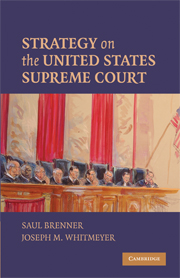Book contents
- Frontmatter
- Contents
- Preface
- PART I INTRODUCTION
- PART II CERTIORARI
- PART III THE CONFERENCE VOTE ON THE MERITS
- PART IV THE MAJORITY OPINION AND OTHER OPINIONS
- PART V THE FINAL VOTE ON THE MERITS
- PART VI CONCLUDING CHAPTERS
- Appendix 1 Decision Making on the United States Supreme Court
- Appendix 2 Additional Questions to Explore
- References
- Table of Cases
- Index
Appendix 1 - Decision Making on the United States Supreme Court
Published online by Cambridge University Press: 05 June 2012
- Frontmatter
- Contents
- Preface
- PART I INTRODUCTION
- PART II CERTIORARI
- PART III THE CONFERENCE VOTE ON THE MERITS
- PART IV THE MAJORITY OPINION AND OTHER OPINIONS
- PART V THE FINAL VOTE ON THE MERITS
- PART VI CONCLUDING CHAPTERS
- Appendix 1 Decision Making on the United States Supreme Court
- Appendix 2 Additional Questions to Explore
- References
- Table of Cases
- Index
Summary
To understand these chapters it is necessary to know something about the procedures involved in decision making on the Court. We present a short summary of these procedures.
The Supreme Court receives requests for review by a number of methods. The most common method is a petition for a writ of certiorari. Certiorari (cert) petitions are of two kinds: paid petitions, in which the petitioner pays the required fees, submits the appropriate number of copies, and follows the other guidelines for submission; and petitions in forma pauperis (i.e., in the form of a pauper), mostly submitted by federal and state prisoners, in which the fees and most of the other requirements are waived.
The cert petitions are typically filed by a litigant who has lost in a U.S. Court of Appeals or in a state supreme court.
The cert petitions are read by a law clerk from the cert pool and by a law clerk from Justice Steven's office (who does not read all of them). The law clerks read the petition and the lower court record, prepare a memo that summarizes the case, and recommends whether cert ought to be granted or denied.
With the help of his law clerks, the chief justice prepares a list of cases to be placed on the Discuss List. Any other justice can add a case to the list. Any case not placed on the Discuss List is automatically denied cert.
The justices meet in secret conference to decide whether to grant or to deny the petitions of the cases on the Discuss List. The justices vote in order of seniority, with the chief justice voting first, the senior associate justice (in terms of tenure on the Court), voting second, and so on. If eight or nine justices are voting, it takes four votes to grant cert. But if only six or seven are voting, it takes three votes.
[…]
- Type
- Chapter
- Information
- Strategy on the United States Supreme Court , pp. 167 - 172Publisher: Cambridge University PressPrint publication year: 2009



